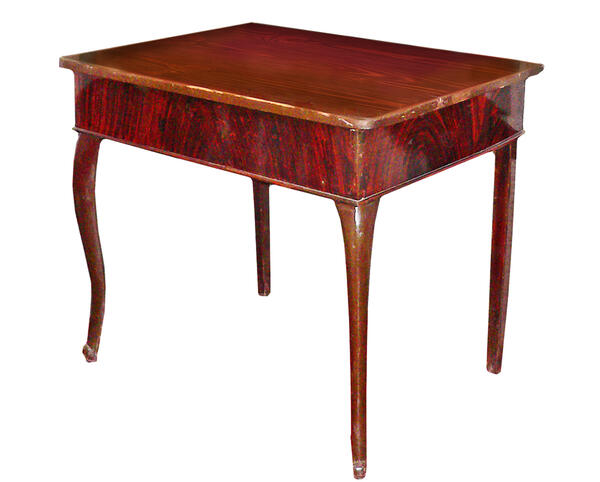The collection of the Kotlas Museum of Local Lore contains this table created at the beginning of the 20th century. Nikolai Dedushénko from Kádnikov, a city in the Sókolsky district of the Vológda region, brought it, along with other antique furniture, to Kótlas and gifted it to the museum.
This piece of furniture belonged to the wealthy Kádnikov merchants of the first guild, the Chetverukhin. The daughter of Evgeny Evgenievich Chetverúkhin, Alexandra, married Kadnikóvsky mayor and merchant Grigóry Fyódorovich Flyágin. They had a son, Ivan. Schoolteacher Nadézhda Ivánovna Póstnikova became his wife, and after the wedding, Ivan Grigórievich and Nadezhda Ivánovna lived in the Chetverúkhins’ large two-story house, which they inherited.
After Nadézhda Ivánovna’s husband died, she lived with her sister Eléna Ivánovna Póstnikova, also a school teacher, in the Odintsóv merchants’ house, the top floor of which had previously been bought by Nadézhda Ivánovna’s husband. The Flyágins sold the Chetverúkhins’ home, and the furniture was inherited by the Póstnikov sisters.
The sisters bequeathed their property to Nikolai Dedushénko, a music teacher, watchmaker and tuner of musical instruments, who worked with them at their school. He was planning to open a historical and memorial apartment for repressed teachers. Nikolai Ivanovich gave a portion of the antique furniture to the Kótlas Museum.
Kádnikov was famous for its masters of wooden art. This furniture may have been made by master cabinetmakers Sokrovín and Orlóv, as well as sourced by foresters Pópov-Vvedénsky, Stratilátov and Súmkin. Craftsmen made this table from expensive wood. It could serve multiple purposes — to be located along the wall as a side table, or as part of a large dining table consisting of two identical tables. For this purpose, there is a metal hook on one of the legs on the inside, and a metal loop on the other leg. Thus, two identical tables could be held together without fear that they would pull apart.
The table is made in a classic style. The frame was fastened with a tenon joint (a style of joint common in woodworking) and two transverse bars. The legs are constructed in different styles — two curved, two more simple straight shapes, with all four tapering downward. After sanding the surface, the table was covered with a dark brown varnish, the legs and the top were painted with brown paint of different shades.
This piece of furniture belonged to the wealthy Kádnikov merchants of the first guild, the Chetverukhin. The daughter of Evgeny Evgenievich Chetverúkhin, Alexandra, married Kadnikóvsky mayor and merchant Grigóry Fyódorovich Flyágin. They had a son, Ivan. Schoolteacher Nadézhda Ivánovna Póstnikova became his wife, and after the wedding, Ivan Grigórievich and Nadezhda Ivánovna lived in the Chetverúkhins’ large two-story house, which they inherited.
After Nadézhda Ivánovna’s husband died, she lived with her sister Eléna Ivánovna Póstnikova, also a school teacher, in the Odintsóv merchants’ house, the top floor of which had previously been bought by Nadézhda Ivánovna’s husband. The Flyágins sold the Chetverúkhins’ home, and the furniture was inherited by the Póstnikov sisters.
The sisters bequeathed their property to Nikolai Dedushénko, a music teacher, watchmaker and tuner of musical instruments, who worked with them at their school. He was planning to open a historical and memorial apartment for repressed teachers. Nikolai Ivanovich gave a portion of the antique furniture to the Kótlas Museum.
Kádnikov was famous for its masters of wooden art. This furniture may have been made by master cabinetmakers Sokrovín and Orlóv, as well as sourced by foresters Pópov-Vvedénsky, Stratilátov and Súmkin. Craftsmen made this table from expensive wood. It could serve multiple purposes — to be located along the wall as a side table, or as part of a large dining table consisting of two identical tables. For this purpose, there is a metal hook on one of the legs on the inside, and a metal loop on the other leg. Thus, two identical tables could be held together without fear that they would pull apart.
The table is made in a classic style. The frame was fastened with a tenon joint (a style of joint common in woodworking) and two transverse bars. The legs are constructed in different styles — two curved, two more simple straight shapes, with all four tapering downward. After sanding the surface, the table was covered with a dark brown varnish, the legs and the top were painted with brown paint of different shades.



